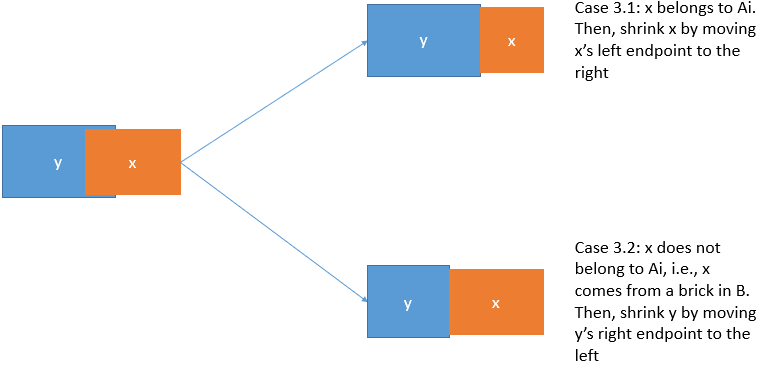Problem: Rectangle Shrinking
Part 1: Notations
$$$x$$$: A brick. $$$x_i$$$ denotes the part of $$$x$$$ belonging to the $$$i$$$-th floor. For example, if $$$x.u=1,\,x.d=2$$$, then $$$x_1.u=x_1.d=1$$$, $$$x_2.u=x_2.d=2$$$, and $$$x_1.l=x_2.l=x.l$$$, $$$x_1.r=x_2.r=x.r$$$.
$$$A_i,\,i=1,2$$$: The set of bricks whose $$$u=d=i$$$.
$$$B$$$: The set of bricks whose $$$u=1,\,d=2$$$.
$$$\texttt{Remove}$$$: Remove a brick $$$x$$$.
$$$\texttt{Shrink}$$$: Shrink a brick $$$x$$$ to another non-empty brick.
$$$\texttt{Keep}$$$: Keep a brick $$$x$$$ unchanged.
Note that in our solution we may operate on a part of brick. For example, for a brick $$$x \in B$$$, we may $$$\texttt{Keep}\,x_1$$$ while $$$\texttt{Remove}\,x_2$$$.
Part 2: Idea
I think $$$\texttt{Shrink}$$$ing $$$x \in B$$$ is troublesome. If you shrink $$$x_1$$$, you have to shrink $$$x_2$$$ in the same way, i.e., $$$x_1$$$ has to be aligned with $$$x_2$$$. So is there a solution that only performs $$$\texttt{Remove}$$$ and $$$\texttt{Keep}$$$ on every $$$x \in B$$$? But that is impossible, because the bricks $$$x, y \in B$$$ may overlap themselves even with considering $$$A$$$. So what if $$$B$$$ are pairwise non-overlapping (because we could perform some pre-$$$\texttt{Shrink}$$$ and pre-$$$\texttt{Remove}$$$ to make $$$B$$$ pairwise non-overlapping)?
In that case, we can consider each floor independently. Let
$$$C_i := A_i \cup \{x_i \mid x \in B \}$$$.
For example, if
$$$A_1 = \{[u=1, d=1, l=2, r=5], [u=1, d=1, l=7, r=10]\}$$$,
$$$B=\{[u=1, d=2, l=2, r=2], [u=1, d=2, l=4, r=7]\}$$$, then
$$$C_1 = \{[u=1, d=1, l=2, r=2], [u=1, d=1, l=2, r=5], [u=1, d=1, l=4, r=7], [u=1, d=1, l=7, r=10]\}$$$.
We sort $$$C_i$$$ w.r.t $$$l$$$, and traverse $$$C_i$$$ like $$$\texttt{for(auto x: C_i)}$$$.
Case 1 ($$$\texttt{Keep}$$$): If $$$x$$$ is not overlapping now, then we add $$$x$$$ to the answer, no matter if $$$x$$$ is from $$$A_i$$$ or not.
Case 2 ($$$\texttt{Remove}$$$): If $$$x$$$ is fully contained in the union of other rectangles, then we always remove $$$x$$$, no matter if $$$x$$$ is from $$$A_i$$$ or not.
$$$\texttt{Keep}$$$ and $$$\texttt{Remove}$$$ are relatively easier, no matter $$$x \in A_i$$$ or $$$x \in \{x_i \mid x \in B \}$$$.
Case 3 ($$$\texttt{Shrink}$$$): If $$$x$$$ is partially overlapping with other bricks.
Case 3.1: If $$$x \in A_i$$$: $$$\texttt{Shrink} x$$$. Move the $$$x.l$$$ to the right to avoid overlapping.
Case 3.2: If $$$x \in \{x_i \mid x \in B \}$$$: $$$\texttt{Shrink}$$$ all bricks that overlap with $$$x$$$ by moving their right endpoints (i.e., *.r), to the left.

It is guaranteed in Case 3.2 that every brick overlapping with $$$x$$$ is from $$$A_i$$$ because we have already performed pre-calculations in $$$B$$$ to make them non-overlapping. The complexity is not an issue, by amortized analysis, each $$$x \in A_i$$$ will do $$$\texttt{Remove}$$$ at most once and $$$\texttt{Remove}+\texttt{Shrink}$$$ at most twice (keep/move left endpoint+keep/move right endpoint).
Part 3: Implementation
First I borrow a range-set implementation from nok0.






